Some chess variant inventions
Cubic chess
 In this 6×6×6 3D variant by Parton, boards are denoted A (bottom level) through F (top level). Each side has six pieces: king (K), queen (Q), bishop (B), unicorn (U), knight (N), and rook (R); and twelve pawns.
In this 6×6×6 3D variant by Parton, boards are denoted A (bottom level) through F (top level). Each side has six pieces: king (K), queen (Q), bishop (B), unicorn (U), knight (N), and rook (R); and twelve pawns.
Game rules
Pieces move the same as in Raumschach, except that pawns move ''and'' capture one step forward (either orthogonally, diagonally, or triagonally), but not directly upward or downward. As in chess and Raumschach, the objective is checkmate. *Variation
Parton made a variation of cubic chess for the same gameboard: In compulsion cubic chess, capture is compulsory, there are no checks, and the object is ''capture'' of the opposing king.Alice chess
 Parton's most famous chess variant, played on two adjacent chessboards. A piece that completes its move on one board automatically "vanishes strangely off its board to appear suddenly on the other board, magically out of thin air!" A move in Alice chess has two basic stipulations: the move must be legal on the board on which it is played, and the square transferred to on the opposite board must be vacant. (Consequently, capture is possible only on the board upon which a piece currently stands.)
From D. B. Pritchard's ''Popular Chess Variants'' (2000):
Parton's most famous chess variant, played on two adjacent chessboards. A piece that completes its move on one board automatically "vanishes strangely off its board to appear suddenly on the other board, magically out of thin air!" A move in Alice chess has two basic stipulations: the move must be legal on the board on which it is played, and the square transferred to on the opposite board must be vacant. (Consequently, capture is possible only on the board upon which a piece currently stands.)
From D. B. Pritchard's ''Popular Chess Variants'' (2000): This wonderful game, appropriately named after Lewis Carroll's eponymous heroine, was the inspiration of Vernon Parton. If you pass over every other game in this book, don't miss this one. Still, alas, little known, Alice chess, now almost a half-century old, continues to attract converts. The body of Alice players grows steadily.
Mad Threeparty chess
This variant is for three players on a 10×10 board. Each player has a standard set of pieces in his own colour, including an extra but no pawns.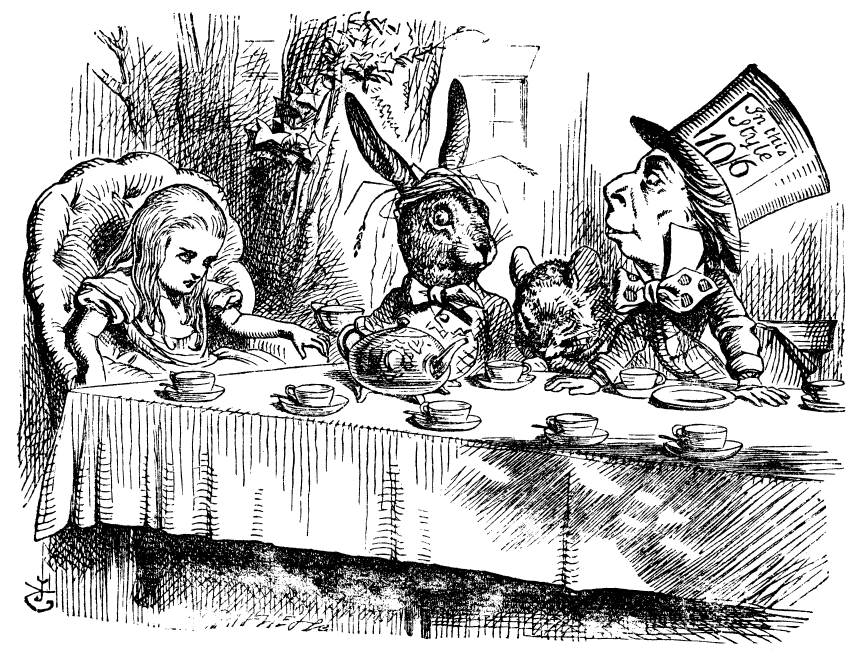
Game rules
The board starts empty. Players take turns, in clockwise rotation around the board, placing one of their pieces on any vacant square. Kings are placed last, but must not be placed inTweedle chess
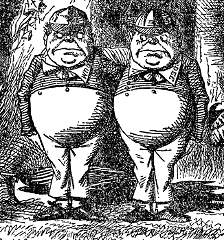 Also known as twin orthodox chess or double-king chess, each player has two kings and two
Also known as twin orthodox chess or double-king chess, each player has two kings and two Game rules
The normal chess rules apply, except that kings andComments
"While his pair of Queens will provide the player's main hopes for victory, his twin monarchs King Tweedledee and King Tweedledum jointly provide his sequence of headaches!" Parton makes note that the only way a player can escape mate from aMarch Hare chess
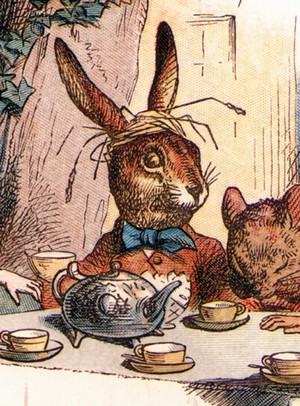
Game rules
For each turn, a player makes ''two moves'': he first moves one of his own pieces, then one of his opponent's men. When a player is in check, he must get out of check immediately on his turn by moving one of his own men. (If he cannot legally do so, he loses the game.)Cheshire Cat chess
Game rules
In this variant, all normal chess rules apply, except: Whenever a piece moves from its square, then that particular square must at once get out of the chessboard. Parton suggests using checker pieces to mark "disappeared" squares. Once vanished, a square may not be occupied again; however, pieces may move ''through'' disappeared square(s), including givingVariation
The game can also be played using a regular 8×8 board and set, but Parton suggests the 10×10 board with two extra rooks in the corners as "best".Co-regal chess
In this variant, the queens are subject to check and checkmate the same as kings.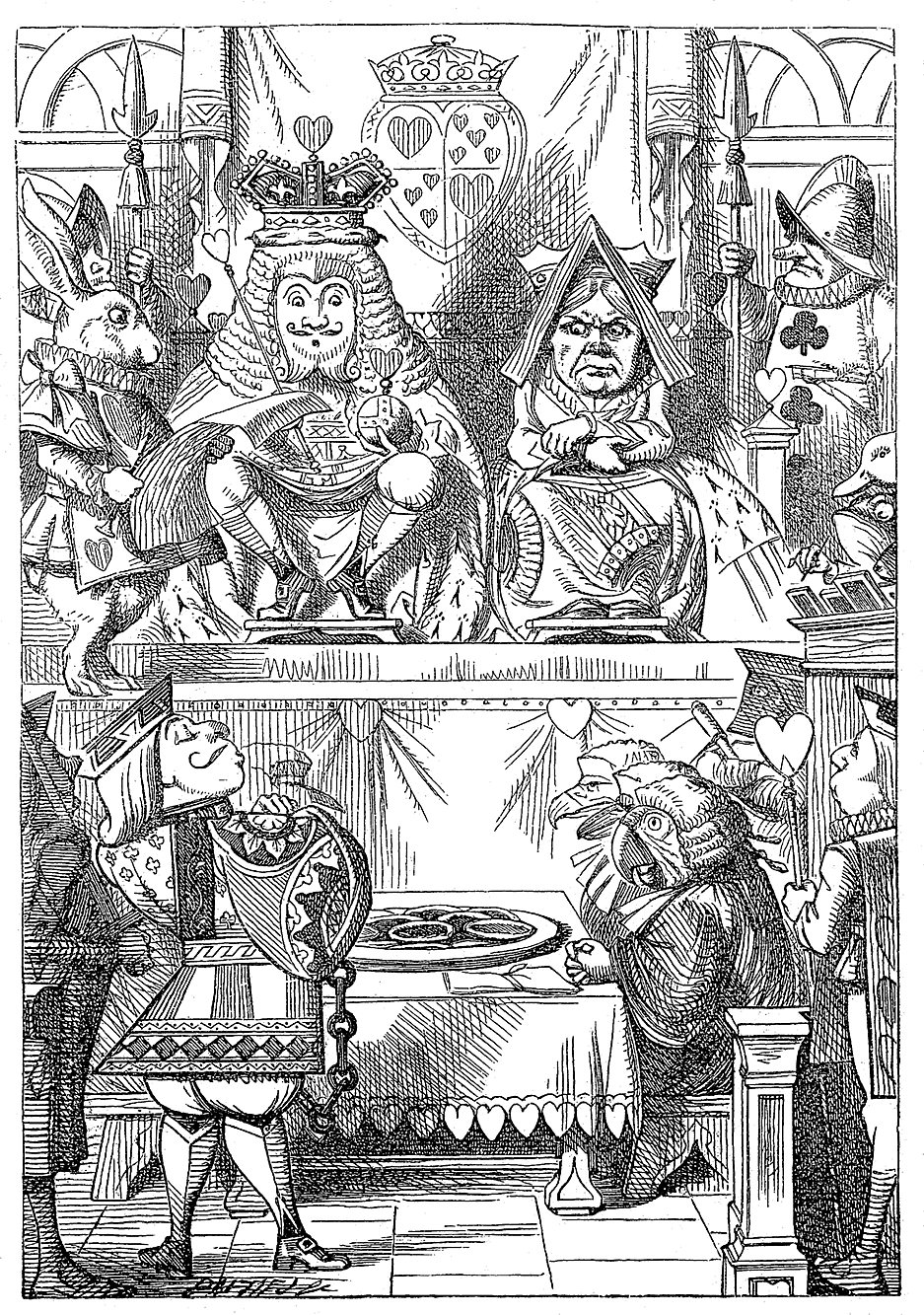
Game rules
Checkmate of the opponent's king or queen wins the game. The queen moves and captures as a normal queen, but may not put itself in check. The queen may pass over attacked squares. Amplified rules by NOST A queen, the result of a pawn promotion, is royal. A queen may check a king from a distance, but may not check a queen. Both kings and queens may castle .Comments
"It will be seen that difficulties for a 'checkmate' of the hostile Queen must chiefly arise from her great mobility which enables her to escape to safety with some degree of ease, in contrast with the King's poor slow power to move out of grave dangers. Victory in Co-regal will be in general achieved by checkmate of the enemy King. ..A player must acquire two new habits at least. He must crush all his desires to make some brilliant Queen sacrifice. When he attacks the hostile co-regal Queen, he is obliged to give the polite word 'check' as warning!"Sample game
Walter Whiteman vs. Rib Orrell: 1.e4 Nf6 2.Nc3 e5 3.Nf3 Bc5 4.Bc4 Ng4 5.0-0 Nxf2+ 6.Rxf2 Bxf2+ 7.Kxf2 0-0 8.d3 d6 9.Ng5 Be6 10.Bxe6 fxe6+ 11.Ke1 h6 12.Nxe6+ Qh4+ 13.g3+ Qxh2 "Black threatens 14...Qg/h1 mate since a K move is illegal as it exposes the Q to check. If 14.Qg4 (only legal move for Q) Rf2 15.Ne2 (forced: Qxg7 is not mate—it's illegal!) Rxe2+ and mate in three."Racing Kings
This game was the original '' Dodo chess'' before being renamed.Pritchard (1994), p. 247 The rules are the same as Dodo chess.Sample game
R. Betza vs. J. Leitel: 1.Bd4 Be4 2.Kh3 Ka3 3.Nxc1 Rxc1 4.Be2 Nb3 5.Bh8? Ka4 6.Kg4 Ka5 7.Qh6 Rc6 8.Qe3 Rxe2 9.Qxe4 Qxh8? 10.Qxc6 Qc3 11.Qh6 Rxe1 12.Rxe1 Qxe1 13.Kf5 Qe7 14.Qe6 Qb7 15.Kg6 Nc5 16.Qf7 Ka6 17.Kh7 Ka7 18.Rg8 (18.Kg8 only draws) Parton suggests also that play can be extended to a "double course", where a player wins by being first to go to the eighth rank and then return to the first.Dodo chess
 Played on a regular chessboard, this variant is a simple
Played on a regular chessboard, this variant is a simple Game rules
Checking is not permitted, neither is exposing one's own king to check. Captures are allowed, however, as in normal chess. "By way of compensating for the first move (always an advantage in a race game) if White gets there first but Black follows on the next move the game is a draw."Kinglet chess
Also known as imperial fiddlesticks, there is no checking or checkmate in kinglet chess – kings are treated like any normal piece. The winner is the first player to capture all the opponent's ''kinglets'' (i.e. pawns or Fiddlesticks).
Additional rules
When reaching the last rank, a kinglet promotes to a king. If a player is forced to promote his last kinglet, he is then without any kinglets so automatically loses. All pieces including kings are subject to capture. Stalemate is a draw.Comments
"The idea contains some interesting problems in tactics. The balance between rushing to capture Fiddlesticks awnsquickly and fear of becoming defenceless thereby, (loss of major pieces) seems to be subtle and delicate."Variations
Parton suggests two "less subtle" variations in ''Curiouser and Curiouser'', one based onLooking-glass chess
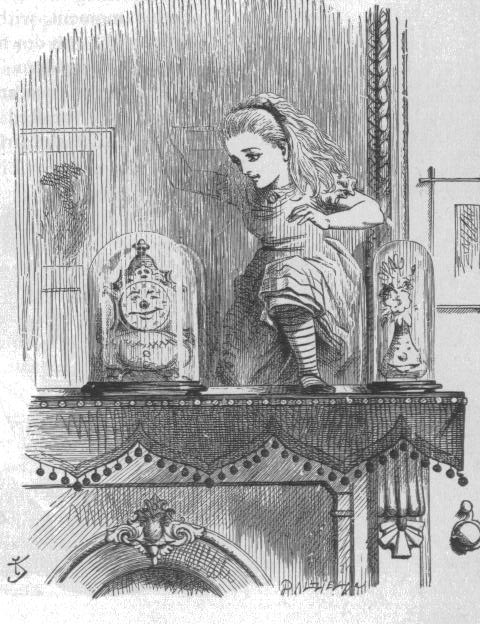 Two separate games ensue in this Parton creation. A player may make any normal move on either board, and then must make the 'looking-glass' (reflected) move on the other board to complete his turn.
Two separate games ensue in this Parton creation. A player may make any normal move on either board, and then must make the 'looking-glass' (reflected) move on the other board to complete his turn.
Game rules
To illustrate, if White opens with 1.Nf3 on board A, then he must play ''1.Nc3'' on board B to complete his turn (see diagram). If a reflected move would put the player in check, then the first move may not be made. The move of a king or queen must be mirrored on the other board, even if this means moving the king several squares. (For example, in the diagram if White captures 2.Nxe5/A Nxd5/B and Black recaptures 2...Qxd5/B, then Black's reflected move is: 2...Kxe5/A.) Castling is normal, but then the reflected move must be executed to 'castle' the queen. (E.g. if White castles kingside, then reflected queenside castling results in the queen on b1 and the rook on c1.)Gryphon chess
Also known as complicacious chess, at the end of a move, the moved piece transforms to a piece of a different type (the next in the series: ''pawn→knight→bishop→rook→queen→king''). So after moving a pawn, the pawn transforms to a knight of the same colour. After moving a knight, it becomes a bishop; and so on. Kings do not transform.
Game rules
A player may have no more than four knights, four bishops, four rooks, or two queens on the board at any one time, but may have as many as fifteen kings. Checkmating any one of the enemy kings wins the game.Comments
"It will be seen at once that a complicacious pawn reaches the status of kingship in five moves, whereas a complicacious Rook does so in two moves. ..Naturally, a player will not capture the enemy Queen! Neither will he desire to move his own Queen, to provide the necessary target for his opponent to win by."Variations
In ''circular'' Gryphon chess, players have one king for the entire game as in normal chess. But the transformation sequence is changed and made circular: ''pawn→knight→bishop→rook→queen→pawn''. (So, a piece can transform any number of times without limitation.) Again, no more than four knights, four bishops, four rooks, or two queens are permitted in play at any one time. In ''simplified'' Gryphon chess, players start with their king and eight pawns. "The pawns change through the regular Gryphon order and terminate in kingship. Until a player has captured an enemy piece, he is forbidden to move his king sideways or backwards."Mock chess
 To win the game, a player must capture all his opponent's pieces, including the king. "A proper pseudomorph to Chess, for it has no elements of check and mate whatever in its basis. Kings are now merely treated like any other chessman."
To win the game, a player must capture all his opponent's pieces, including the king. "A proper pseudomorph to Chess, for it has no elements of check and mate whatever in its basis. Kings are now merely treated like any other chessman."
Game rules
If a player can capture, he must do so. If more than one capture are possible on his turn, he may choose which one to make. Only one capture per turn may be made. On its first move, a pawn must advance ''two'' squares—unless the pawn's first move is a capture.Contramatic chess

Game rules
Players start with kings positioned as shown. White places his remaining pieces anywhere he likes on his side of the board, then Black does the same. White moves first. Checking the opponent is not allowed. (If a player has no move other than to give check, then he loses.) A player may make a move putting his own king in check from enemy piece(s)—unless the move would also give check to the opponent. When a player is in check, his opponent must remove the check on his next turn or lose the game.Observations
Kings tend to move more than any other piece. Kings cannot occupy adjacent squares, since it would result in giving check to the opponent (in violation of the rules). Captures are rare, since capturing the opponent's men reduces the chance of putting one's own king in check.Variation
In Complete Contramatic chess (also known as C.C.C.) each player has ''two'' kings – a normal (orthodox) king in addition to the regular "contramatic" king. There are two ways to win: putting one's own contramatic king into inescapable check, or checkmating the enemy orthodox king. Players place the orthodox kings last, after other pieces are placed.Observations
A contramatic king can move to a square adjacent to the enemy orthodox king (since the orthodox king may be checked as in normal chess, and the contramatic king may put itself into check). But an orthodox king may ''not'' move adjacent to the enemy contramatic king (since it is not allowed to check an opponent's contramatic king, or to put one's own orthodox king into check).Idle Kings' chess

Game rules
Players play without kings until after Black's 12th move, when White places his king on any open square (but not in check), and Black does the same.Additional rule
After kings are placed the game continues normally, except that kings may not move, unless in check.Unirexal chess
Also known as The Black King's Complaint, Unirexal variants are those with only one king on the board. "The black king disappeared, explains Parton, because he was fed up with always being mated in problems."
Game rules
Black has a second queen instead of a king, and must checkmate White in a reasonable number of moves (agreed to before the game), otherwise White wins.Variation
Black has twenty knights, but no king. If Black does not checkmate White within 50 moves, he loses.Decimal Rettah chess
 This is Parton's first chess variant invention. The idea sprang from a dislike for weak kings: "The king ought to be strong, not feeble, by aesthetic standards: he is the centre around which turns the whole game itself. In consequence, my Rettah monarch is the most powerful of all pieces."
Each player has two rettahs (kings) and two queens on a 10×10 board. There is no checkmate; a player wins by capturing both opponent's rettahs.
This is Parton's first chess variant invention. The idea sprang from a dislike for weak kings: "The king ought to be strong, not feeble, by aesthetic standards: he is the centre around which turns the whole game itself. In consequence, my Rettah monarch is the most powerful of all pieces."
Each player has two rettahs (kings) and two queens on a 10×10 board. There is no checkmate; a player wins by capturing both opponent's rettahs.
Game rules
A rettah 'hatter'' spelled backwardsmoves and captures as a Q+N compound. If a rettah is attacked, the attacking piece must be captured immediately. (If more than one piece is able to capture, the player may choose. An attacked rettah will always have the option to capture.) If a rettah is attacked by two pieces simultaneously, the attacked rettah must capture one of them (the player may choose which). Pawns can move up to three steps on their first move. There is no ''Variations
Parton gives several variations, although Decimal Rettah is "possibly the earlier version and arguably the better" . In Absolute Rettah chess, only a rettah may capture a rettah. (So a successful tactic involves attacking a rettah with a piece guarded by one's own rettah.) In Giveaway Rettah, Decimal or Absolute Rettah are played according to Suicide chess rules. In Rettah chess (one rettah; pawns move only one step forward) and Double Rettah chess (two rettahs; no forced capture; win by checkmating a rettah), play is on a regular 8×8 board.Sample game
Decimal Rettah, "a game of assault and sacrifice", received high praise from Boyer who published the following sample game he game uses an alternate initial setup NBKQRRQKBN and incorrect interpretation of the capture rule, requiring that only a rettah may capture its attacker :1.c3 f6 2.Qb3 Rf8 3.Qxb9+ Kxb9 4.Bf5+ Kxf5 5.e4+ Kxe4 6.f3+ Kxf3 7.Rxf3 Qc6 8.Rh3 Qxc3+ 9.Kxc3 Rc8+ 10.Kxc8 dxc8 11.Qc5 e7 12.Rxh9+ Kxh9 13.Qh5+ Kxh5 14.Ni3+ Kxi3 15.Kxi3 1–0Identific
 In this variant, the identity of chess pieces becomes known as play proceeds.
In this variant, the identity of chess pieces becomes known as play proceeds.
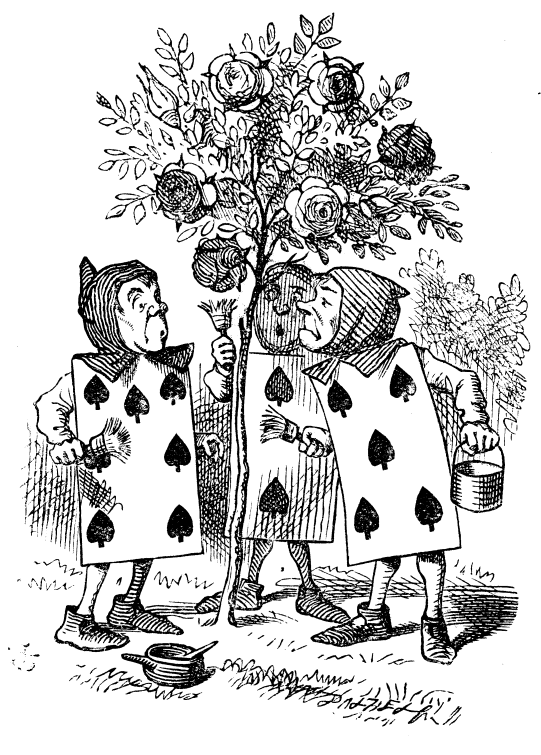
Game rules
Players first place their 12 counters (draughtsmen) on any squares of their choosing on their own half of the board. (Either White places all his counters first, followed by Black; or one per turn if the players prefer.) After all counters have been placed, White moves any one of his counters as a regular chess piece of his choosing, then immediately replaces that counter with the corresponding chess piece. Black does similarly on his turn. These "moves of identification" obey the following rules: After each player has identified one chess piece, on subsequent turns players may choose to identify an additional piece from those still in-hand, or move one of their chess pieces already on the board. Chess pieces move, capture, give check/checkmate as normal, and may capture enemy counters. A player's fourth identified piece must be his king. (Or the players can agree on a different schedule, for example, the sixth identified piece.) Players might also want to prevent the early identification of queens, for example, by requiring at least five identifications, or by limiting identification of queen to a player's last-remaining counter.Synchronistic chess
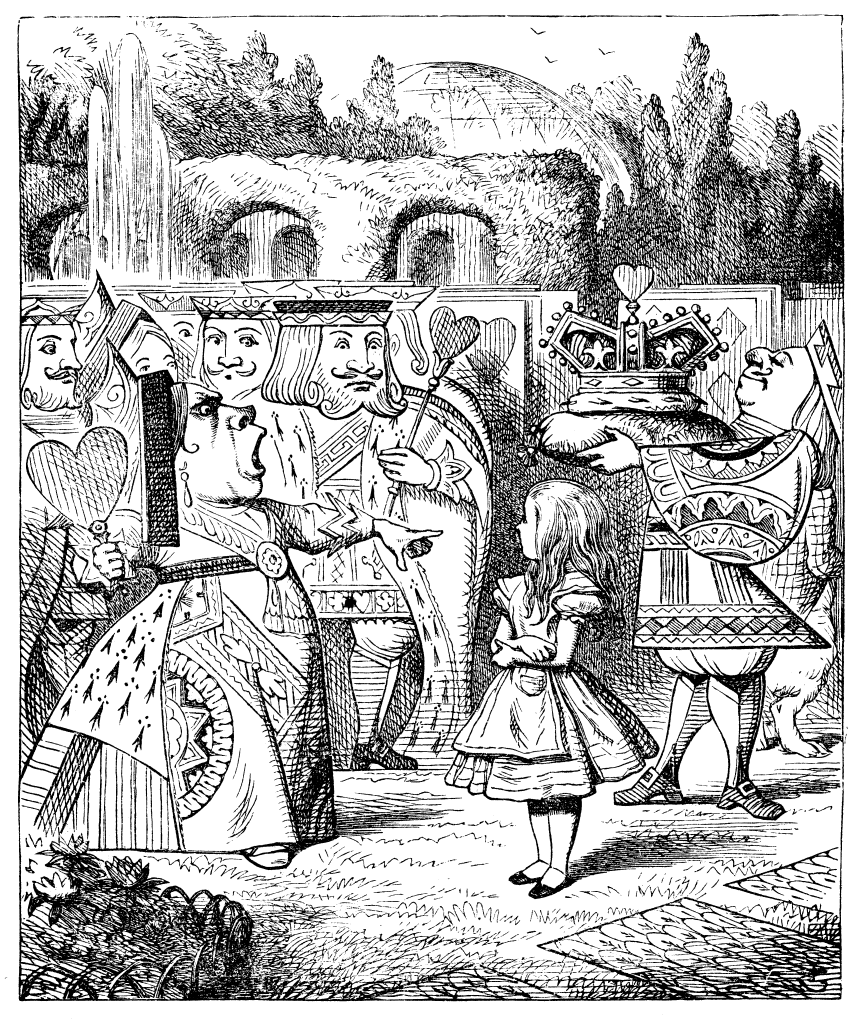 "A variant designed, part tongue-in-cheek, to achieve absolute equality."
" ..to eliminate altogether that inequality between White and Black, by the simple idea that White and Black shall always play their corresponding moves simultaneously!"
"A variant designed, part tongue-in-cheek, to achieve absolute equality."
" ..to eliminate altogether that inequality between White and Black, by the simple idea that White and Black shall always play their corresponding moves simultaneously!"
Game rules
For each turn players decide their moves, write them down secretly, then disclose them. They adjust the position accordingly, using the following rules of resolution when needed: In Synchronistic Chess, simultaneous checkmate is possible.Damate
Also known as Damate Game, the game is a synthesis between
Game rules
A king has no and is considered a normal ; a player wins by eliminating all the opponent's men. The pieces move normally, except that pawns have no initial two-step option, and besides their normal one-step move straight forward, can move one step diagonally forward. A piece captures an enemy piece by ''jumping'' it: As in draughts, jumping is always mandatory, multi-jumps are possible, and the multi-jump chosen must capture the maximum number of pieces possible. (If more than one jumping sequence captures the maximum, the player may choose.) The pieces captured in a multi-jump are not removed from the board until the end of the turn. A pawn promotes to queen when it crosses the centre line of the board. A pawn jumping over the centre line both promotes and immediately ends the turn (i.e. no further jumps are allowed).Dunce's chess
 Also known as Advancing chess, the game has simple rules: Moves, captures, and checks are restricted to straight forward or diagonally forward directions. (Sideways or backwards is not permitted.) Pawns do not promote. The game is won by checkmating or stalemating the opponent.
Also known as Advancing chess, the game has simple rules: Moves, captures, and checks are restricted to straight forward or diagonally forward directions. (Sideways or backwards is not permitted.) Pawns do not promote. The game is won by checkmating or stalemating the opponent.
Variations
Semi-queen chess
Also known as half-queen's chess, the game introduces two additional pawns and two new pieces per side, the "ugly-named Biok and Roshop".
Game rules
The Biok makes non-capturing moves like a bishop, and captures like a rook. The Roshop makes non-capturing moves like a rook, and captures like a bishop. As a result, the Roshop "has the great advantage of being able to change from one colour system of squares to the other when required" .Variation
Parton defines an extension having no additional pawns and a pair of Bioks and Roshops per player.Black and White chess
 Also known as Black and White Marseillais chess, this game follows a simple rule: each player makes two moves per turn, first with a standing on a white (light) square, then with a man standing on a black (dark) square. Some resolutions are provided:
Castling can be done on either the first or second move of a turn. A man can be moved ''twice'' in a turn if square colour requirements are met. (For example, with a white pawn on a2 and a black bishop on b4, White's turn can consist of a3 followed by axb4.)
Also known as Black and White Marseillais chess, this game follows a simple rule: each player makes two moves per turn, first with a standing on a white (light) square, then with a man standing on a black (dark) square. Some resolutions are provided:
Castling can be done on either the first or second move of a turn. A man can be moved ''twice'' in a turn if square colour requirements are met. (For example, with a white pawn on a2 and a black bishop on b4, White's turn can consist of a3 followed by axb4.)
List of game inventions
Chess variants
* Checkers chess (1950s) * Decimal four-handed chess (1950s) * Idle Kings' chess (1950s) * Nightrider chess (1950s) * Scaci Partonici (1950s) * Decimal Rettah chess (1952) * Double Rettah chess (1952) * Parton's Game (1952) * Rettah chess (1952) * Tweedle chess (or Twin Orthodox chess) (1952) *Draughts variants
* Alician Draughts (1956) * Damate (1961) * Dragon * Kinger, Simple Kinger, and Grand Kinger * ScoundrelsOther games
* SalterelloMonographs (with section headings)
''Curiouser and Curiouser'' (1961), 31 pp. * Scacetic * The First Lesson in Chess * Dunce's Chess in Three Grades * Imperial Fiddlesticks * The Queen's Relations * The Dodo's Chess * Rettah * Simpletonry * Alician * The Black King's Complaint * Tweedledee and Tweedledum * Mock Turtle's Pseudomorphy * Damification * A New Pudding * Podospherism * Contramatic * The Rules According to the March Hare * Knightmares * Gryphon's Fancy and Fun * The Realm of Circum Morus * The Caterpillar's Idea of C.C.C. ''Challenge and Delight of Chessical and Decimal'' (1970), 14 pp. ''Chesshire-Cat-Playeth Looking-Glass Chessys'' (1970) Part I, 14 pp. * The Queen of Hearts' Chess * Capricorn Chess * The Black King's Complaint * The Rules According to the March Hare * Identific * Synchronistic Chess * Jabberwocky Chess * Dodo Chess ''Chesshire-Cat-Playeth Looking-Glass Chessys'' (1970) Part II, 13 pp. * The Chesshire Cat's Grin * Scaci Partonici * A Chess Reflection * Demigorgons * The Mad Tea Party * Knightmares * Scaci Partonici ''Chessical Cubism or Chess in Space'' (1971), 16 pp. * Cubic Chess * Tamerlane Variation of Cubic Chess * Sphinxian Chess * The Compulsion Sphinx Chess Variations * Ecila Chess ''100 Squares for Chess + Damante'' (1971), 16 pp. * Capablancan Chess * Decimal Falcon-Hunter (Schulz Chess) * Half-Queen's Chess * Decimal Oriental Chess * Decimal Imitante Q Chess * Centaur Royal * Damate Game * Damatic Chess * Decimal Duffer's Chess * Wyvern Chess * Dabbabante Chess * Decimal Butter * Decimal Obstacles Chess * Chimaera * Gorgona * Circean * Ambi-Chess * Decimal Scaci Partonici ''My Game for 2000 A.D. and After'' (1972), 12 pp. ''Enduring Spirit of Dasapada'' (1973), 19 pp. * Dasapada ''Idea for a Personal Game'' (1973), 12 pp. * The Basis of Pawn Partonici * The Idea of Scaci Partonici ''Chessery for Duffer and Master'' (1974), 23 pp. * Chessery for Duffer and Master * The Game of Rettah Chess * Semi-Queen Chess * The Diversion of Zerta * Meddlers Chess Game * The Alice chess Game * The Idea of Gryphon Chess * Royal FuryNotes
References
Bibliography * * * * * * * * *Further reading
*External links
Vernon Rylands Parton (1897–1974)
by Jean-Louis Cazaux, ''
Alice chess
by Edward Jackman and Fergus Duniho, ''
Black and White Chess
by
Cheshire Cat Chess
by
Kinglet
by
Kinglet
by Uwe Wiedemann,
Racing Kings and Dodo Chess
by
Rettah
by Vu Q. Vo., ''
Unirexal Chess
by
Alice Chess
{{DEFAULTSORT:Parton, V. R. 1897 births 1974 deaths British chess writers Chess variant inventors People from Cannock People educated at Cannock Chase High School